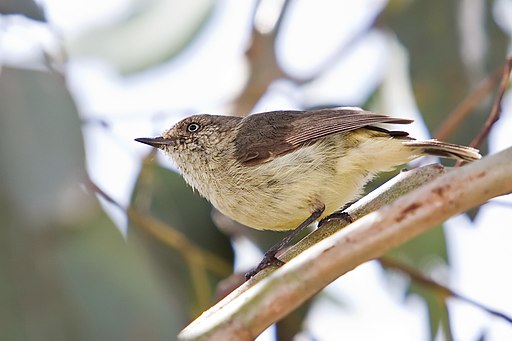Acanthiza reguloides
Superregnum: Eukaryota
Regnum: Animalia
Subregnum: Eumetazoa
Cladus: Bilateria
Cladus: Nephrozoa
Superphylum: Deuterostomia
Phylum: Chordata
Cladus: Craniata
Subphylum: Vertebrata
Infraphylum: Gnathostomata
Superclassis: Tetrapoda
Cladus: Reptiliomorpha
Cladus: Amniota
Classis: Reptilia
Cladus: Eureptilia
Cladus: Romeriida
Subclassis: Diapsida
Cladus: Sauria
Infraclassis: Archosauromorpha
Cladus: Crurotarsi
Divisio: Archosauria
Subsectio: Ornithodira
Subtaxon: Dinosauromorpha
Cladus: Dinosauria
Ordo: Saurischia
Cladus: Theropoda
Cladus: Neotheropoda
Infraclassis: Aves
Ordo: Passeriformes
Subordo: Passeri
Parvordo: Corvida
Superfamilia: Meliphagoidea
Familia: Acanthizidae
Genus: Acanthiza
Species: Acanthiza reguloides
Subspecies: A. r. australis - A. r. nesa - A. r. reguloides - A. r. squamata
Name
Acanthiza reguloides Vigors & Horsfield, 1827
References
Transactions of the Linnean Society of London (1) 15(1826) p.226
Vernacular names
English: Buff-rumped Thornbill
español: Acantiza reguloide
فارسی: نوکخاری کفلکاهی
français: Acanthize à croupion beige
Nederlands: Vaalstuitdoornsnavel
русский: Корольковая шипоклювка
svenska: Rostgumptaggnäbb
The buff-rumped thornbill (Acanthiza reguloides)[3] is a species of thornbill found in open forest land in eastern Australia, specifically around Sydney, south of Chinchilla and east of Cobar[4] in an area of 1,000,000–10,000,000 km².[1] The buff-rumped thornbill is found in temperate or subtropical/tropical moist environments[1] living and feeding amidst the foliage or on the ground.[5] However, they are known to prefer nesting sites one to two metres above ground level, particularly amongst the bark of trees.[5] Of a similar size to other thornbills, 8–10 cm long, the buff-rumped thornbill is identifiable by its "buff-coloured rump and belly"[4] and white irides in its eyes.[5]
Since 1926 the buff-rumped thornbill and the varied thornbill (A. squamata) have been combined as a single species,[6] despite considerable differences between extreme examples of the two groups.[4] The buff-rumped thornbill is described as 'uncommon' on some occasions. However, it is not deemed to be endangered and has been in the low risk category for the International Union for Conservation of Nature and Natural Resources since 1988.[1]
File:Buff-rumped Thornbill girraween.ogvPlay media
Wallangarra, S. Queensland, Australia
References
Wikimedia Commons has media related to Acanthiza reguloides.
BirdLife International (2016). Acanthiza reguloides. The IUCN Red List of Threatened Species 2016. doi:10.2305/IUCN.UK.2016-3.RLTS.T22704638A93978394.en
Gill F, D Donsker & P Rasmussen (Eds). 2020. IOC World Bird List (v10.2). doi : 10.14344/IOC.ML.10.2.
Koenig, Walter and Dickinson, Janis (2004) Ecology and Evolution of Cooperative Breeding in Birds. Cambridge University Press. p. 72. doi:10.1017/CBO9780511606816. ISBN 978-0-511-21161-4
Ford, J. (1985) Pigment and Morphometric Variation in the Buff-rumped Thornbill. p. 53
Wildlife Buff-rumped Thornbill Acanthiza reguloides reguloides Archived October 6, 2007, at the Wayback Machine retrieved June 18, 2007
Schodde, R. (1975) Interim List of Australian Songbirds: Passerines. RAOU, Melbourne.
Retrieved from "http://en.wikipedia.org/"
All text is available under the terms of the GNU Free Documentation License


